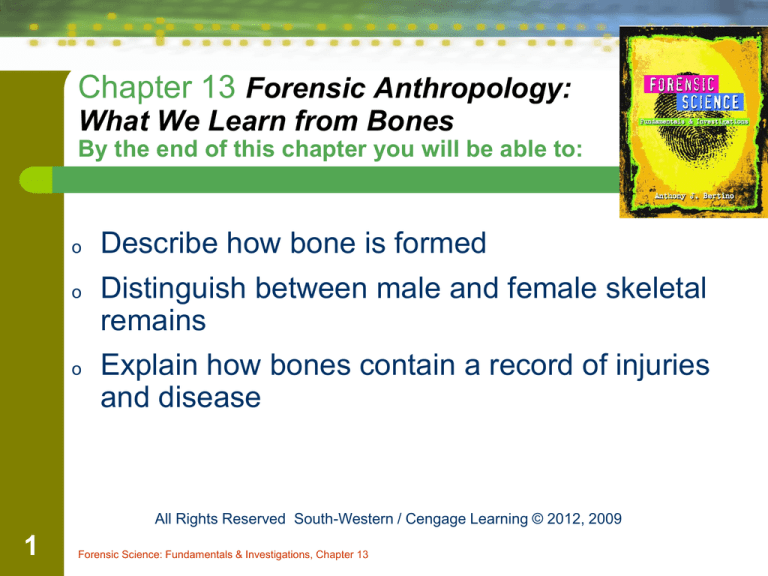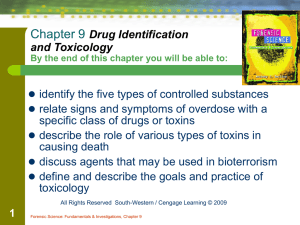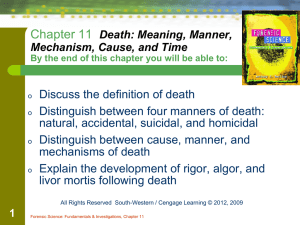
Chapter 13 Forensic Anthropology:
What We Learn from Bones
By the end of this chapter you will be able to:
o
Describe how bone is formed
o
Distinguish between male and female skeletal
remains
o
Explain how bones contain a record of injuries
and disease
All Rights Reserved South-Western / Cengage Learning © 2012, 2009
1
Forensic Science: Fundamentals & Investigations, Chapter 13
Chapter 13 Forensic Anthropology:
What We Learn from Bones
By the end of this chapter you will be able to:
o
2
Describe how a person’s approximate age
could be determined
o
Explain the differences in facial structures
among races
o
Discuss the role of mitochondrial DNA in bone
identification
Forensic Science: Fundamentals & Investigations, Chapter 13
Forensic Anthropology
o
o
o
3
Anthropology—the scientific study of all
aspects of human development and
interaction
Physical anthropology—studies human
differences
Forensic anthropology—studies these
identifying characteristics on the remains of
an individual
Forensic Science: Fundamentals & Investigations, Chapter 13
Historical Development
o
o
o
o
4
1800s—scientists begin studying skulls
1897—sausage maker’s wife murdered; bone
fragments found in his factory
1932—the FBI opens the first crime lab
Smithsonian Institution partners with FBI
Forensic Science: Fundamentals & Investigations, Chapter 13
Historical Development
o
o
o
5
1939—William Krogman publishes Guide to
the Identification of Human Skeletal Material
Soldiers killed in World War II are identified
using anthropologic techniques
DNA—new tool to analyze skeletons
Forensic Science: Fundamentals & Investigations, Chapter 13
Characteristics of Bone
o
o
o
6
Bones are alive
Marrow—creates blood cells
Hormones affect the amount of
calcium in the blood and bones
Forensic Science: Fundamentals & Investigations, Chapter 13
Development of Bone
o
o
o
o
7
Osteoblast cells—where bones originate
Ossification—when osteoblast cells migrate
to the center of cartilage production and
deposit minerals
Life cycle—bone is deposited, breaks down,
and replaced
Osteoclasts—the 2nd type of bone cell,
specialized to dissolve bone
Forensic Science: Fundamentals & Investigations, Chapter 13
Development of Bone
o
Osteoclasts—the 2nd type of bone cell
•
•
•
•
o
8
Specialized to dissolve bone
Allows bones to reshape as they grow
Balances calcium levels in blood
Removes cellular wastes and debris from bones
Osteoporosis—a deficiency of calcium in the
bones
Forensic Science: Fundamentals & Investigations, Chapter 13
How Bones Connect
cartilage—wraps the
ends of bones for
protection and
prevents scraping
9
Forensic Science: Fundamentals & Investigations, Chapter 13
How Bones Connect
ligaments—bands that connect two or more
bones together
10
Forensic Science: Fundamentals & Investigations, Chapter 13
How Bones Connect
tendons—connect
muscle to bone
11
Forensic Science: Fundamentals & Investigations, Chapter 13
Aging of Bone
o
o
o
12
Under 30 years of age—bones increase in
size
Over 30—process reverses
Exercise slows deterioration
Forensic Science: Fundamentals & Investigations, Chapter 13
What Bones Can Tell Us
o
o
o
Osteobiography—bones contain a record
of the physical life
Analyzing bones reveals clues to gender,
age, height, and health
Examples:
•
•
13
In a right-handed person, right arm bones might
be slightly larger than the bones of the left arm
X-rays may identify prior fractures, pins, artificial
joints
Forensic Science: Fundamentals & Investigations, Chapter 13
Gender—Skull
Male
Characteristics
14
Trait
Female
Characteristics
More square
Shape of eye
More rounded
More square
Mandible
shape from
underside
More V-shaped
Thick and larger
Upper brow
ridge
Thin and smaller
Forensic Science: Fundamentals & Investigations, Chapter 13
Gender—Skull
Male
Characteristics
15
Trait
Female
Characteristics
Present
Occipital
protuberance
Absent
Low and sloping
Frontal bone
Higher and
more rounded
Rough and
bumpy
Surface of
skull
Smooth
Straight
Ramus of
mandible
Slanting
Rough and
bumpy
Nuchal crest
Smooth
Forensic Science: Fundamentals & Investigations, Chapter 13
Gender—Skull
o
o
o
o
16
Is the female skull smoother than the male’s?
Which frontal bone is lower and sloping?
Are the male’s eye orbits more circular?
Which jaw is more square, with an angle that
is closer to 90o?
Forensic Science: Fundamentals & Investigations, Chapter 13
Gender—Pelvis
o
o
o
17
An easy method to determine gender
The surface of a woman’s pelvis can be
scared
The sub pubic angle of the female pelvis is
greater than 90o; the male’s, less
Forensic Science: Fundamentals & Investigations, Chapter 13
Gender—Thigh bones
The male femur is
thicker and joins the
pelvis at a straighter
angle than the female
femur
18
Forensic Science: Fundamentals & Investigations, Chapter 13
Age—Skull
19
o
By about age 30, the suture at
the back of the skull closes
o
By about age 32, the suture
running across the top of the
skull, back to front, closes
o
By about age 50, the suture
running side to side over the top
of the skull, near the front, closes
Forensic Science: Fundamentals & Investigations, Chapter 13
Age
o
o
o
o
o
20
At birth—450+ bones in the
skeleton
Adults— 206 bones
Epiphysis line—appears where
cartilage is replaced by bone
When the cartilage is fully replaced,
the line is no longer visible
This information can be used to
approximate a skeleton’s age
Forensic Science: Fundamentals & Investigations, Chapter 13
Age—Epiphysis
21
Forensic Science: Fundamentals & Investigations, Chapter 13
Age—
Epiphysis
22
Forensic Science: Fundamentals & Investigations, Chapter 13
Height
o
o
23
An estimate of height can be made by
measuring one of the long bones
Gender and race is taken into consideration
Forensic Science: Fundamentals & Investigations, Chapter 13
How to Distinguish Race
o
o
o
o
o
o
24
Shape of the eye sockets
Absence or presence of a nasal spine
Measurements of the nasal index
Prognathism
Width of the face
Angulation of the jaw and face
Forensic Science: Fundamentals & Investigations, Chapter 13
Facial Reconstruction
o
o
Facial muscles follow the contour of the skull
A face can be rebuilt from just skeletal remains
•
•
o
o
25
Facial markers are positioned at critical locations
Clay is contoured to follow the height of the markers
Computer programs perform a similar function
Computer programs also can “age” missing
persons and criminals
Forensic Science: Fundamentals & Investigations, Chapter 13
DNA Evidence
o
o
o
o
26
Bone contains little nuclear DNA but it does
contain mitochondrial DNA
Nuclear DNA degenerates before mitochondrial
DNA
Mitochondrial DNA is inherited only from the
mother
Compare results with living relatives on the
mother’s side of the family
Forensic Science: Fundamentals & Investigations, Chapter 13
Skeletal Trauma Analysis
o
o
Forensic anthropologists determine if damage
to bones occurred before or after death
Distinct patterns exist for damage by
• Environment
• Sharp-force trauma
• Blunt-force trauma
• Gunshot wounds
• Knife wounds
27
Forensic Science: Fundamentals & Investigations, Chapter 13
. . . . . . . . . . . . . Summary . . . .
o
o
o
o
28
Bones are live and carry on all life functions.
Bone condition can tell investigators about a
person’s health and nutrition during life.
Male and female skeletons differ.
The age of a person at death can be estimated
by analyzing bones.
Forensic Science: Fundamentals & Investigations, Chapter 13
. . . . . . . . . . . . . . . . . Summary
o
o
o
o
29
A person’s height can be estimated by the
length of long bones.
Facial reconstruction is possible to some
extent.
Mitochondrial DNA can be extracted to help
identify skeletal remains.
Skeletal trauma analysis examines bones for
evidence of damage.
Forensic Science: Fundamentals & Investigations, Chapter 13








